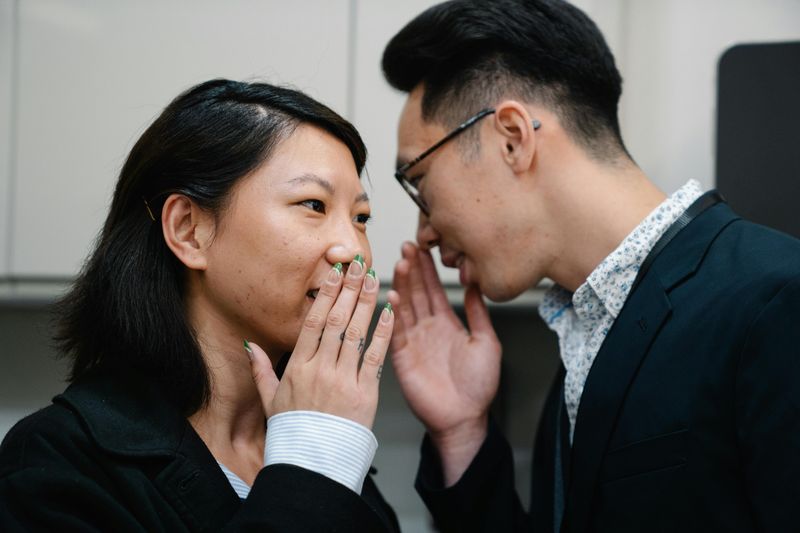Have you ever felt like someone shows a different side of themselves depending on who’s around? Two-faced people wear masks that change based on what they want or who they’re with.
They say one thing to your face and another behind your back. Spotting these behaviors early can save you from confusion and hurt feelings in your relationships.
1. Telling Different Stories
Stories shift like sand depending on who’s listening. A two-faced person might tell you they were sick last weekend, but tell their boss they were helping a family member move. They change important details to look good or avoid trouble.
Pay attention when stories don’t add up. If you hear them tell the same event differently to different people, it’s not just forgetfulness—it’s a deliberate tactic. Their goal is to control how everyone sees them, even if it means bending the truth.
2. Sweet Talk That Feels Fake
Compliments flow like honey but leave a strange aftertaste. Two-faced individuals shower you with praise that feels over-the-top or oddly timed. “Your presentation was absolutely brilliant!” they gush, while privately telling others it was boring.
This excessive flattery serves as a tool for manipulation. They’re building you up to either get something from you or to mask their true feelings. Their words often don’t match their actions, creating a disconnect that might leave you feeling confused.
3. Dodging Blame Like Bullets
Mistakes happen around them, but somehow they’re never responsible. When confronted, a two-faced person quickly points fingers at others or circumstances beyond their control. “I would have finished the project, but Mark didn’t give me the files I needed!”
This blame-shifting protects their carefully crafted image. Notice how they become defensive when questioned, often turning situations around to make themselves the victim. Their reputation remains spotless in their own narrative, while others carry the burden of their mistakes.
4. Spreading Rumors Like Wildfire
Secrets don’t stay secret for long around them. A truly two-faced person might listen sympathetically to your problems, then share those details with others, often with embellishments. “Just between us” means nothing to them.
Gossip serves as their social currency. They collect information about others and distribute it strategically to gain favor or create divisions. Watch for the person who suddenly knows personal details about others that weren’t publicly shared – they’re likely getting this information through back-channel conversations.
5. Making Excuses on Repeat
Life seems extraordinarily complicated for these folks. Car troubles, family emergencies, and technology glitches happen with surprising frequency. “My phone died” becomes their catchphrase when they fail to respond to messages they’d rather ignore.
The pattern reveals itself over time. Their excuses often contain dramatic elements that make questioning them seem insensitive. By creating elaborate justifications, they avoid accountability while maintaining their image. The goal isn’t to solve problems but to escape consequences for their inconsistent words and actions.
6. Promises Made of Thin Air
“I’ll definitely help you move this weekend!” they enthusiastically declare. Yet Saturday comes, and they’re nowhere to be found. Broken promises leave a trail of disappointment behind two-faced individuals.
They commit easily in the moment because it makes them look good or helpful. The problem? They never intended to follow through. Their words are designed for immediate approval rather than genuine commitment. After several cycles of this behavior, you might notice they make promises most freely when they want something from you.
7. Vanishing When Needed Most
Reliability isn’t their strong suit. Two-faced people might be present for celebrations and good times but mysteriously absent when challenges arise. The friend who loves your party invitations might be unreachable when you need emotional support.
This selective availability reveals their true priorities. They want the benefits of relationships without the responsibilities. Did you notice they’re quick to ask for favors but slow to return them? Their pattern of disappearing acts speaks volumes about how they value others versus themselves.
8. Keeping Secrets About Everything
Mystery surrounds them like a fog. Questions about their weekend plans receive vague answers, while details about their past remain sketchy. “Oh, just hanging out with some people you don’t know” becomes their standard response.
This secretive behavior isn’t about privacy – it’s about control. By compartmentalizing information, they can present different versions of themselves to different people. They carefully manage what each person knows about them. This strategic withholding makes it nearly impossible to see the full picture of who they truly are.
9. Switching Sides Without Warning
Loyalty means little to those wearing two faces. One day they’re firmly on your side in a disagreement; the next, they’re agreeing with your opponent as if they never supported you. Their allegiance follows opportunity rather than principle.
This flip-flopping creates confusion and mistrust. Friends might compare notes and discover this person said completely opposite things to each of them. The strategy allows them to maintain favor with everyone, regardless of conflicting interests. Their ultimate loyalty is only to themselves and whatever serves their interests in the moment.
10. Truth Served Only When Convenient
Half-truths become an art form with two-faced individuals. They share just enough factual information to seem honest while strategically omitting critical details that might paint them in a negative light. “Yes, I was at the restaurant” (but not mentioning with whom).
This selective honesty creates a false sense of transparency. They appear forthcoming while actually controlling the narrative. Pay attention to what’s left unsaid in their stories. The gaps often reveal more than what they choose to share, and questions about these missing pieces may be met with defensiveness or topic changes.











